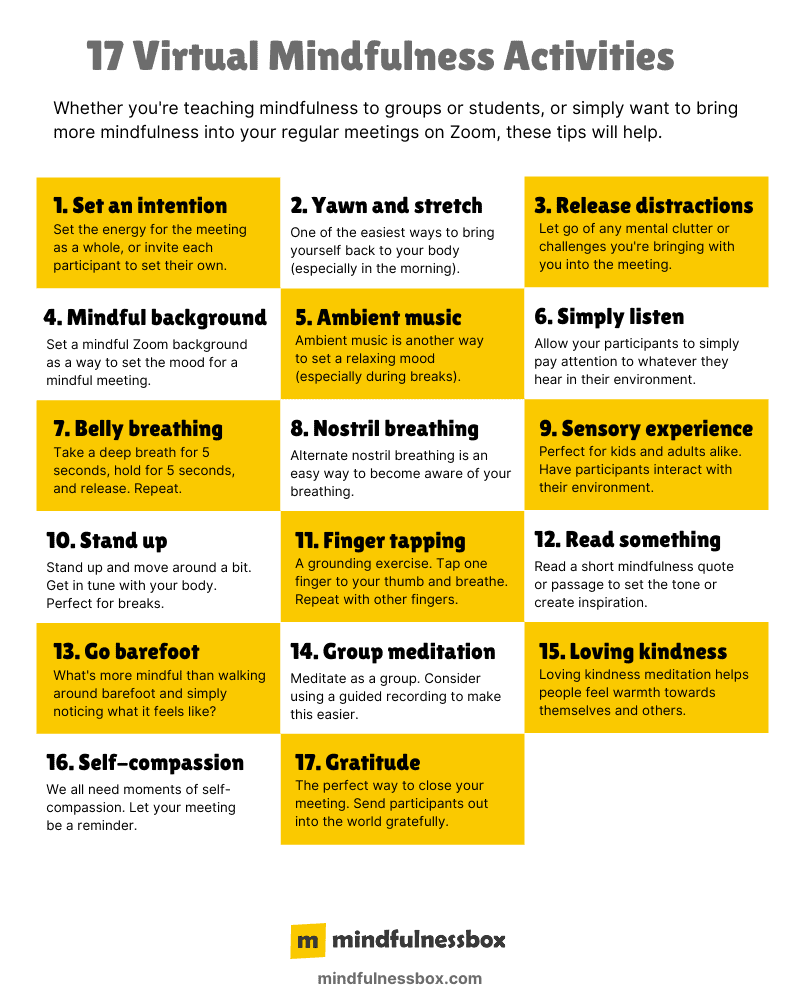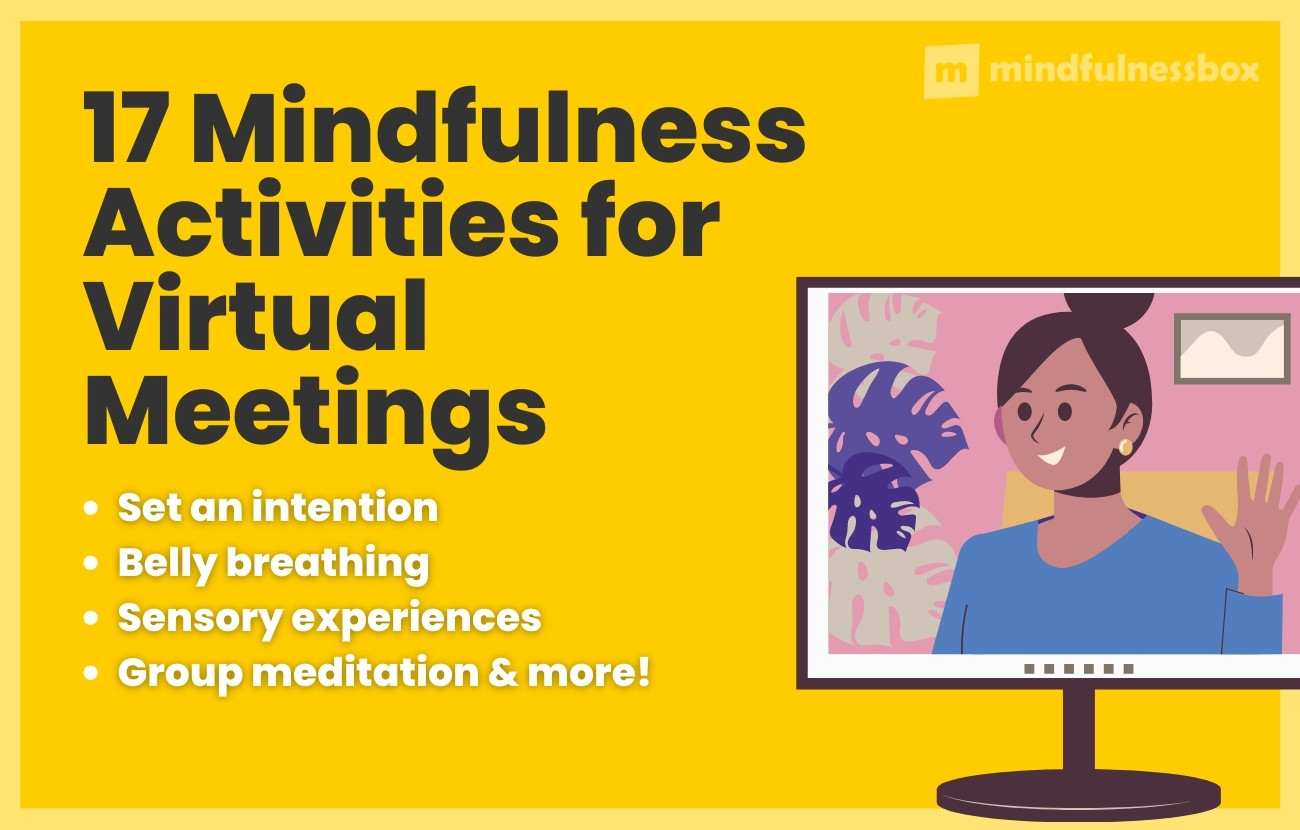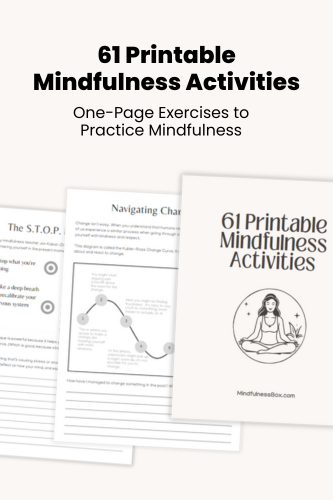Virtual meetings can be chaotic. Whether you’re trying to manage a virtual classroom full of students, running a business meeting, or conducting a remote seminar, mindfulness can help. Try including mindfulness exercises to start a meeting, or to reset a meeting’s energy in the middle of long sessions.
Right now, at this very minute, thousands of mindlessly-designed meetings are happening on Zoom.
“Hi, can you hear me?”
Get dozens of one-page exercises to help practice mindfulness, meditation, gratitude, and self love. Perfect for printable handouts when teaching mindfulness to groups, students, or in the workplace.
To see examples, plus a full list of the 61 exercises included, click below.
“Sorry—just let me get my mic—”
“Okay, so does anyone have anything they want to talk about today?”
Don’t let that be you.
Even Zoom meetings that are specifically designed to teach mindfulness to adults or kids can fall into an unstructured rhythm that make it hard for participants to feel immersed.
From setting an intention for your session, to incorporating a “mindful minute” into a meeting, to running entire sessions based around mindfulness, the following online mindfulness activities will help you create a more mindful virtual environment.
17 Virtual mindfulness activities
Whether you’re teaching mindfulness to groups or students or looking for mindfulness activities over Zoom to start your meetings more calmly, these tips will help.

1. Set an intention for your session
Meetings all need a purpose and an outcome, but intention-setting goes beyond that. Invite your participants to consider what their own private intention is.
For example, “My intention is to live with joy today and stay grounded throughout the day.” You may also want to guide the group by setting an intention for the session as a whole.
2. Yawn and stretch
If it’s a morning meeting, especially, or a meeting with younger students, the yawn and stretch technique can help as a bit of an icebreaker (by acknowledging that it’s early and we’re all a little tired).
But yawning and stretching slowly is also a mindfulness exercise in its own right. It can bring you back to your body, helping you notice and release areas of tension. 20-30 seconds is long enough for this exercise.
3. Release distractions
Participants in your session are sure to be bringing with them all kinds of mental clutter: maybe they showed up late, maybe they recently hurt someone’s feelings, maybe they had a busy morning, maybe they have a long to-do list to attend to after the call.
Encourage them to acknowledge they’re holding feelings and distractions, and to give themselves permission to release them for the duration of the session.
4. Add a mindful Zoom background
Okay, this one might be a little controversial. Zoom backgrounds can be distracting. Some are tacky. But as a way to set the environment, consider using them as a tool.
A clean, Zen-like background with soft lighting might help set the mood for a more mindful session.
5. Add ambient music
Consider adding mindful music, if appropriate and not distracting, especially if your session contains meditation practice or time for silence or reflection.
6. Simply listen
Tell your participants to take a moment to take their earbuds out and simply listen to what’s around them. What do they hear? Whether they hear traffic, birds chirping, or people or animals in their home making noise, encourage them to give their attention fully to the soundscape wherever they are.
7. Belly breathing
Lead participants in a deep breathing exercise. Take a deep breath for five seconds, letting the air fill your belly. Then, hold for five seconds. Then exhale for five seconds. Finally, hold for five seconds again before starting the process over.
8. Alternate nostril breathing
Alternate nostril breathing can help regulate the nervous system and is often used for relaxation and mindfulness to calm the body. Start by placing your thumb on your right nostril, and breathing slowly through the left nostril. Then switch. Repeat the process 3-4 more times.
9. Create a sensory experience
This can be harder on a Zoom call since you’re not physically present, but it’s worth it.
If you aren’t able to plan anything in advance, you can invite people to savor whatever they’re drinking: water, tea, coffee, soda. Take a sip, and hold the liquid in the mouth before swallowing. Then swallow, and notice the sensation of the liquid entering the body. Notice the temperature of it. Notice how it feels to swallow.
If you’re designing mindfulness activities online for kids, have them grab their favorite toy from nearby, or really anything they can find. Focus on the sensation of touch: how does it feel when they move their hand slowly across the surface of the object? What about using their fingernail versus the surface of their finger?
The raisin mindfulness exercise is another good way to engage the full spectrum of senses, perfect for online mindfulness activities for students and adults.
10. Stand up and tune into your body
Movement meditation is always a good way to break up Zoom sessions, especially when everyone is sitting down for long periods of time.
Have your participants stand up and take a deep breath, tuning into their bodies and noticing how they feel. Invite them to pay attention to any physical sensations, and observe if they’re positive or negative.
Finally, this is a good time for them to do a mental “reset” and consider what intention they’d like to bring to the rest of the session.
11. Finger tapping
Finger tapping is a good option if you’re looking for mindfulness exercises to start a meeting: it can help slow your breathing, calm your nervous system and bring you in tune with your body.
Hold your index finger to your thumb, take a deep breath, and exhale. Then do the same for your middle finger, your ring finger, and your pinky finger. Then, move backwards, tapping your ring finger, middle finger, and index finger to your thumb. Repeat the cycle.
12. Read a short mindfulness story or passage
Kids will enjoy a short illustrated story that gets across some aspect of mindfulness. For adults, sharing insights from meditation teachers like Thich Nhat Hanh can be a good approach.
To get your participants’ full attention, share your screen and bring up your book or quotes as a PDF.
13. Go barefoot
Another mindfulness exercise to get participants moving, walking barefoot can be a great way to focus on sensations they normally don’t notice.
Have participants take their socks and shoes off and walk around on the carpet or floor. What feelings do they notice? Is there any other surface they can step on? How does it compare? You can also plan a walking meditation session. Playing a guided meditation may be helpful here.
14. Virtual group meditation
Have your participants slow down and get quiet, after setting an intention and ensuring the group’s energy is ready to settle down.
Sessions of any length are possible, from one minute to much longer. Consider using a guided meditation like an app or podcast to keep the group’s attention focused, especially for those who are new to meditation.
If you’re working with groups of children or younger students, have them think about how they feel, and inhale and exhale deeply and slowly; consider using a guided meditation targeted towards children.
For virtual meditation team building exercises, or virtual mindfulness activities for employees, try these guided meditation scripts for self-love and gratitude.
15. Loving kindness meditation
Towards the end of your mindfulness session, start moving the energy towards love, compassion and gratitude to help participants enter their day with positive energy.
Loving kindness meditation can help as a compassion exercise. Start by having participants focus on someone they feel deep and unequivocal love and kindness for: a pet, perhaps, or a younger sibling.
As they breathe, have them focus on sending feelings of love and kindness to that person or animal. Then, have the object of loving kindness change to someone they feel neutrally about. Then, to all beings in the world.
16. Have a self-compassion moment
Many of us struggle with compassion for ourselves, and this is true even within the context of a meditation Zoom meeting.
Perhaps participants in the session felt like they haven’t performed well in the meditation or group mindfulness activities. Perhaps they’ve been distracted during the session, even though they intended not to be.
Encourage them to let it all go, and hold compassion for themselves instead. They showed up. They’re building a practice. They should be proud of themselves.
17. Take time for gratitude
As the session closes and participants go off into their days, encourage them to think about three things their grateful for, whether it’s something that took place during the session, or anything else in their life.
Getting started with virtual mindfulness activities for groups

Practicing mindfulness virtually isn’t quite the same as doing so in a physical environment. However, with a few tweaks and a creative approach, you can help people feel more mindful from anywhere.
There’s a lot to process in the list above, but a few points are key.
First, a good way to set yourself up for success from the start is to set an intention for your mindfulness session, and to have participants do so too. You can also make the session more mindful from the start by incorporating visuals and sensory experiences (even including Zoom backgrounds and music). You also want to help participants notice their energy and let go of distractions they may be bringing into the experience.
Second, many mindfulness activities can be easily accommodated to a virtual environment, from breathing exercises to finger tapping to meditation. Just make sure to break up long periods of stretching with interactive activities, especially those that let people stand up and move around.
Third, and finally, help your participants move into their day with positive energy by steering the session towards self-compassion, loving kindness and gratitude at the end.
Whether you’re designing virtual mindfulness activities for adults, virtual mindfulness icebreakers, or virtual mindfulness games, remember: the end goal isn’t the activity itself, but the energy and intention your participants put into it.
Frequently asked questions
How do you teach mindfulness virtually?
Most mindfulness exercises that can be done in person can be done virtually. The challenge is to hold your participants’ attention and create an immersive experience from a distance.
Because of this, having them close their eyes and use headphones can be helpful to bring them more deeply into the experience. For example, you can use ambient music to create a more relaxed atmosphere, then have participants do breathing exercises or activities to explore their senses.
You can also have your participants stand up and move around (mindfully) to break up the sitting time.
Planning grounding exercises for Zoom meetings
Practicing virtual grounding exercises for meetings on Zoom is a great way to create deeper connections and more mindful meetings, and bring greater intention to your virtual interactions.
First, check in with the energy you’re bringing into the meeting. Any to-do lists you have or emotional baggage you’re carrying, let it go for the duration of the meeting.
Second, show compassion to other participants in the meeting by checking in with them. How are they doing? If they seem stressed or agitated, keep in mind that you don’t know what they’re going through.
Third, breathe. Remember to keep your nervous system balanced with deep breaths. As needed, take short breaks to do an emotional reset by turning off your camera and microphone.

My mindfulness practice kicked off in 2016 with a ten-day silent retreat. Since then, I’ve read dozens of books about mindfulness and completed hundreds of hours of meditation. Thinking about what makes humans happy, calm, and peaceful is endlessly fascinating to me.


